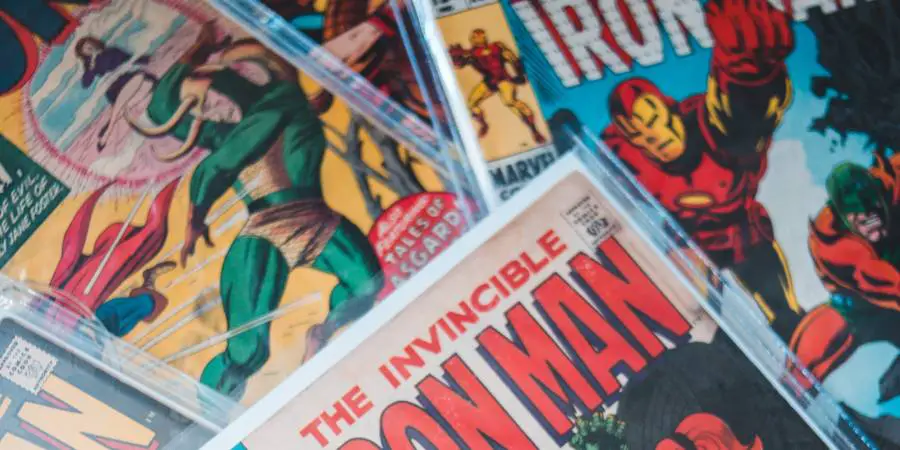How Many Pages Are in a Comic Book?

When you buy a comic book, it normally has a set number of pages in it, and it almost always seems like it is in multiples of 4. This practice is pretty standard in the industry, but did you know why there’s a specific length or a particular number of pages in each comic book?
The number of pages in a comic book is in multiples of 4, such as either 24 or 32 pages. Comics typically include a letters page and a few adverts, while the plot should be roughly 21- 22 pages long for a 24-page comic or 28- 30 pages long for a 32-page comic book.
In this article, we’ll discuss the following:
- The adequate number of pages for comics.
- The reason behind that specific page count.
- How a graphic novel is different from comics.
- A few of the popular comics’ sizes.
Let’s get started.
Why Do Comics Have a Page Count in Multiples of Four?
Comic books’ page counts are usually in multiples of four, such as 8, 16, 24, and so on. This might seem odd, considering that most books have a random number of pages. But why is this?
Comics have a page count in multiples of four because when printing most of the bindings, the printer produces a parent sheet. This contains a page count of 8, 16, or 32 on one of the sheets of paper based on the size of your comic book. The printer cuts and staples them together to make a book.
While the page number is usually divided by four, the page count doesn’t have to be a multiple of four for spiral-bound or wire-bound projects. However, board books are printed differently, with only two-page spreads required.
Printing Technicalities
To elaborate this word count requirement further, each comic “page” is a section of a bigger sheet printed on many pages, which are then folded into a “signature” group. Three edges of the signature are cut off for a saddle-stitched book, and this is how a comic book’s pages are formed.
Interestingly enough, a comic book’s most popular overall page count is 32, with the cover pages, since most offset printers function with 16 or 32-page signatures. You’ll be wasting paper if you have more or fewer page counts than the signature while still spending on it.
As a result, the most cost-effective total page counts, including cover pages, for printed comic books are 32, 64, or 96.
Other Page Count Variations
Of course, there’s a stipulation. Not every offset printer utilizes a 32-page signature, as some only use 16. So, you’d also have the alternatives of 16, 48, and 80.
The second variation is that current digital printers don’t make an effort to notify you of any of this. Instead, they stick to the simple rule of four. They’ll publish your book if the number of pages is divisible by four to explain this further.
You’ll still be charged for the squandered paper, but you’ll never know.
Can You Have As Many Pages As You Want in Comics?
Before the advent of digital distribution, single-issue comics had to be an even number for printers. These days, it’s less of an issue, considering who you print/publish with.
You may have as many pages as you want in comics. This is due to the modern techniques stepping in to make an effort to maintain the number of issues in your comic book to an even number, such as 32 pages.
In addition, most comic books are published in a series of four to six issues. The occasional 7th or 8th issue can be found, although these are uncommon.
As a result, a four-series comic book with 100 words per page and 32 pages has a total word count of 12,800 words and 188 pages. These figures are not set in stone and change depending on the comic creator’s interests and preferences.
Once you’ve crossed the line and reached 96 pages, you know you have entered the territory of a graphic novel. It’s always a good idea to check with your planned printer/digital publisher beforehand if they have any limits or rules.
What Is the Difference Between Comics and Graphic Novels?
To communicate a story, both comic books and graphic novels employ a combination of graphics and text. It doesn’t matter if the narrative is fiction or nonfiction if it’s about a superhero or a catastrophic event.
The difference between comics and graphic novels is mainly the size and presentation. A graphic novel is often 60 to 500 pages long, whereas the average comic book is 22 pages long and provides a primarily self-contained plot.
The Page Count of DC or Marvel Comics
In today’s comics, Marvel and DC feature 20 pages of plot, but the comics themselves are usually 32 pages long. The front cover, front inner cover, back cover, and back inside cover are four of those pages.
They’re both made of the same stuff, as it’s less expensive that way.
Previously, Marvel/DC such as the Marvel Mighty Marvel Masterworks (available on Amazon.com) comics tended to feature 22 pages of plot, with the odd exception of a third page, generally at the price of the letters section.
Independent comics can do anything they want, but for an ongoing series, they generally stick to 20 to 25 pages of plot in a 32-page format.
Conclusion
The most common big obstacle for many comics writers who are attempting to write comics for the first time are:
- Trying to put too much on a page.
- The number of pages a comic book has.
Publishers say comic issues range from 20 to 30 pages, including advertisements, and without ads, it’s estimated at 16 to 26 pages.
Comic books have a set length, which is around 32 pages. On the other hand, graphic novels are often lengthier, ranging from 60 to 500 pages, whereas, the number of pages in a comic book should be in multiples of four.






